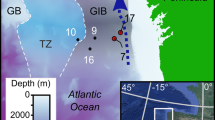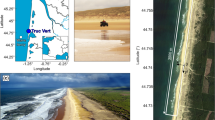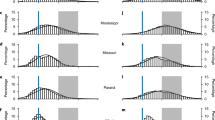Abstract
Tidally formed cross-bedding sets in which mud drapes are spaced out among sandy foresets occur in Cretaceous1–4, Eocene5 and Holocene6 sands deposited subtidally by strongly asymmetrical sand waves. A striking feature of some sets4,6 is that the horizontal drape spacing, measured in the direction of sand-wave advance, varies cyclically on a time scale related to the spring–neap tidal cycle as indicated by the numbers of drapes. Each drape forms part of a distinctive lithological couplet, consisting of a group of sandy foresets recording avalanching on the steeper side of the sand wave, followed by the drape itself, typically divided into upper and lower parts by a centrally placed silt‐sand parting. The drapes have been assigned to slack water, but the groups of sandy foresets to episodes of vigorous flow, the combination suggesting a quantitative model based on the tide. Here I show how the peak speeds and ranges of ancient tides can be estimated by combining an empirical bedload transport function with appropriate measurements from such cross-bedding sets.
This is a preview of subscription content, access via your institution
Access options
Subscribe to this journal
Receive 51 print issues and online access
$199.00 per year
only $3.90 per issue
Buy this article
- Purchase on Springer Link
- Instant access to full article PDF
Prices may be subject to local taxes which are calculated during checkout
Similar content being viewed by others
References
Allen, J. R. L. & Narayan, J., Geologie Mijnb. 43, 451–461 (1964).
Allen, J. R. L. Sediment. Geol. 26, 281–328 (1980).
Allen, J. R. L. Geol. Mag. 117, 437–446 (1980).
Allen, J. R. L. Nature 289, 579–581 (1981).
Nio, S. D. Geologie Mijnb. 55, 18–40 (1976).
Visser, M. J. Geology 8, 543–546 (1981).
Klein, G. deV. Bull. geol. Soc. Am. 82, 2585–2592 (1971).
Klein, G. deV. Bull. geol. Soc. Am. 83, 539–546 (1972).
Bagnold, R. A. The Physics of Blown Sand and Desert Dunes (Methuen, London, 1941).
Gadd, P. E., Lavelle, J. W. & Swift, D. J. P. J. sedim. Petrol. 48, 239–242 (1978).
Bagnold, R. A. Prof. Pap. U.S. geol. Surv. 422 -I (1966).
Gilbert, G. K. Prof. Pap. US. geol. Surv. 86 (1914).
Guy, H. P., Simons, D. B. & Richardson, E. V. Prof. Pap. U.S. geol. Surv. 462 -I (1966).
Doodson, A. T. & Warburg, H. D. Admiralty Manual of Tides (HMSO, London, 1941).
Hydrographer of the Navy Admiralty Tide Tables, Vol. 1 (Taunton, 1980).
Jopling, A. V. J. Geol. 75, 287–305 (1967).
Allen, J. R. L. Georgr. Annlr A53, 157–187 (1972).
Jopling, A. V. & Forbes, D. L. Geogr. Annlr A61, 67–85 (1979).
Allen, J. R. L. J. Geol. 78, 326–351 (1970).
Colby, B. R. Prof. Pap. U.S. geol. Surv. 462 -A (1964).
Author information
Authors and Affiliations
Rights and permissions
About this article
Cite this article
Allen, J. Palaeotidal speeds and ranges estimated from cross-bedding sets with mud drapes. Nature 293, 394–396 (1981). https://doi.org/10.1038/293394a0
Received:
Accepted:
Issue Date:
DOI: https://doi.org/10.1038/293394a0
This article is cited by
-
Paleoenvironments and hydrocarbon reservoir potentials from the selected sedimentary basins in Nigeria using sedimentary facies and textural analyses
Journal of Sedimentary Environments (2022)
-
Measurements of sediment transport on the sea bed southwest of England
Geo-Marine Letters (1984)
Comments
By submitting a comment you agree to abide by our Terms and Community Guidelines. If you find something abusive or that does not comply with our terms or guidelines please flag it as inappropriate.



